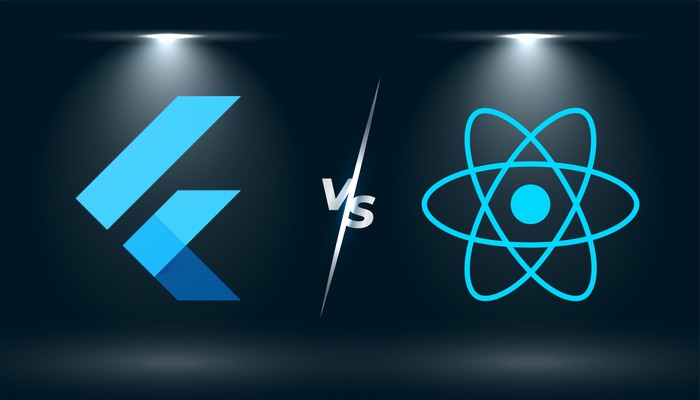Mar 25, 2024
Flutter vs. React Native: Which Framework Is Better For Your Project?
Flutter and React Native are two of the most widely used cross-platform mobile app development frameworks.
These open-source frameworks, backed by Google and Meta, enable you to deliver native app experiences across the Android, iOS, and web ecosystems using a single codebase. They save you money on development by allowing you to reuse your code across multiple apps. They also allow you to ship new features faster to all of your target platforms because they require less coding than native app development. As a result, your ongoing maintenance will also be reduced.
But which platform is better, Flutter or React Native? There are several factors to consider when deciding between Flutter and React Native for cross-platform app development. In this guide, we will go over each of these in detail.
What is Flutter?
Flutter, Google's open-source multiplatform mobile app development framework, was launched in 2017 with the goal of enabling you "to deliver high-performance apps that feel natural on different platforms, embracing differences where they exist while sharing as much code as possible." Flutter has come a long way to become the cross-platform framework of choice for developers looking to build apps that feel native everywhere:
On phones (including foldable phones! run any OS (Android or iOS)
Throughout the web (inside any browser and even when it's cast to a large HDTV monitor)
On desktops running any operating system (Windows, MacOS, or Linux)
Because Flutter is a multiplatform framework, you only need to write one codebase, and it allows you to deliver native app experiences across all of these ecosystems directly. However, because Android and iOS are two of the most important target platforms for mobile app developers, Flutter includes support for both the Material and Cupertino design systems.
When discussing the Flutter Framework, the keyword is "adaptive." Flutter allows you to create apps that adapt to any device they are accessed from.
Flutter is used to power apps by a wide range of companies, including publishers such as the New York Times, eCommerce giants such as Alibaba, and SaaS companies such as Square.
What is React Native?
Facebook's open-source multiplatform app development framework, React Native, was launched in 2015. It was built on top of its React project to enable the delivery of native app experiences on iOS and Android devices with a single codebase. React Native is the second most popular cross-platform development framework, after Flutter.
React Native, like Flutter, allows you to create apps that feel natural across a variety of ecosystems (mobile, desktop, and web).
While Flutter has gained popularity in recent years, React Native has also maintained its hold. In fact, the React Native community is excited about the framework's long-awaited "New Architecture." Currently available for experimental purposes,
Facebook uses React Native to power some of its mobile apps. Like Flutter, React Native is popular in a variety of industries. React Native is used to power cross-platform apps by everyone from ecommerce giants like Amazon and Flipkart to consumer apps and technology companies like Microsoft.
Let's take a look at how Flutter and React Native compare in terms of programming languages, UI approaches, ease of learning and adoption, performance, security, and more, so you can choose the best option for your project.
Flutter vs. React Native
Programming Languages
React Native employs Javascript, a language that all mobile developers are familiar with and enjoy. Familiarity with Javascript has been one of the primary motivators for React Native's adoption in cross-platform apps.
In contrast, Flutter makes use of Dart, a programming language developed by Google. Many developers considering the Flutter framework view learning and using Dart as a challenge. Dart, on the other hand, is easier to learn than most people realize because it is similar to C# and Java.
Google chose Dart for Flutter because it wanted a language that could deliver high performance. Dart is also designed for performance, with features such as strong typing. Furthermore, Dart is a compiled language, whereas Javascript is an interpreted language, which means that Dart will always outperform Javascript in terms of performance parameters such as speed. By the way, both iOS and Android use compiled languages (Swift and Kotlin, respectively) as official languages for reasons of speed and performance.
Ease of learning
Javascript is widely used, which is reflected in the cross-platform frameworks chosen by mobile teams. For example, suppose you have a team of expert Javascript developers and want to transition to a cross-platform framework. In that case, you could just stick with React Native. You have all the necessary expertise.
Furthermore, if you're familiar with Javascript, you're familiar with the entire ecosystem of frameworks, libraries, SDKs, and other tools that work in tandem with it. This means that developing a native app using the Javascript ecosystem is already simple for you.
Choosing Flutter entails devoting time and resources to learning Dart. When Google decided to try Flutter for its Google Pay app, it had to make more hires and retrain its engineers.
Also, because Flutter lacks a rich ecosystem like Javascript, you may need to spend time developing workarounds if you can't find ready-to-use resources. So there is a learning phase here. However, finding the right building blocks for your app in the Flutter ecosystem should speed up the process.
Cross Platform-ness
To a large extent, UI rendering determines whether your cross-platform app feels native on its target platforms. Both React Native and Flutter perform well here.
With React Native's bridge architecture, an app's Javascript code runs in a separate Javascript engine and communicates with native platform components via a bridge (a type of communication layer). This bridge architecture allows React Native to render the user interface of its cross-platform app using native platform components. Because React Native delivers UI using native components from the target ecosystem, its apps feel "natural."
In contrast, Flutter completely bypasses a native platform's UI elements and renders the app's UI directly using its widgets (UI components). Flutter renders these widgets to the target ecosystem without using native UI components. Flutter's rendering not only provides designers and developers with the flexibility they require to build their apps, but it also delivers pixel-perfect designs across all target platforms.
Delivering apps that look native.
React Native allows you to define platform-specific styling for your UI elements across all of your target platforms. You can specify how a specific app component should behave on Android and iOS. Flutter also allows you to create platform-specific themes that style your UI elements differently for Android and iOS versions. Flutter also provides platform-aware widgets, which automatically adapt to the ecosystem in which they are launched.
Platform-specific behaviors
Scrolling behaves very differently between Android and iOS devices. That's why, for a cross-platform app to feel native, the underlying framework must correctly implement platform-specific behaviors. Here, too, React Native and Flutter provide comparable performance. Both provide mechanisms for managing ecosystem-specific features and functionalities.
Performance
Flutter appears to have a performance advantage over React Native. This leads back to the languages that they use. Flutter is built with Dart, which allows for ahead-of-time compilation. As a result, Flutter apps start up much faster because the native code it compiles for the various target platforms requires no interpreting in runtime. React Native's Javascript, on the other hand, tends to add overhead because it is an interpreted language, and the runtime interpretation adds overhead.
Just-in-time compilation optimization can help improve Javascript performance, but it still takes effort. Dart (Flutter) gives you a head start here.
However, the performance of your Flutter or React Native app is determined by factors other than the underlying framework's language. The runtime environment, how you code, and the optimizations you use all have an impact on the performance of your app. With the right coding and optimizations, you can make both deliver comparable performance.



